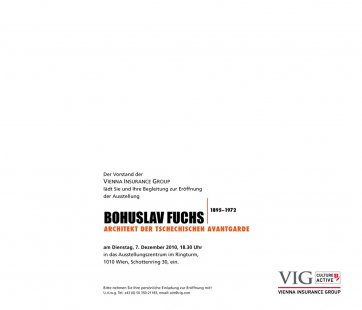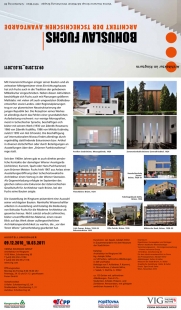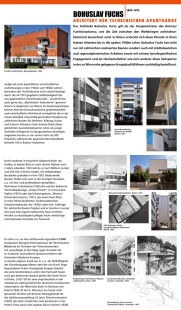
In Vienna, an exhibition about the architect Bohuslav Fuchs has started
Vienna - An exhibition titled Bohuslav Fuchs - Architect of the Czech Avant-garde has started today at the exhibition center in the Ringturm building in Vienna. The event will present the author of famous functionalist buildings in Brno, such as Zeman's Café and the Avion Hotel, to the audience in the Austrian capital until March 18. According to one of the curators, Adolph Stiller, this is the first time Fuchs' life work is being presented internationally.
The exhibition features photographs of Fuchs' most renowned buildings and original plans for some of them. Original items that were once in the buildings are also on display. For instance, there are chairs and coat hangers from the Brno Zábrdovice baths, door handles from the former Moravian Bank in Brno's Freedom Square, and railings from the Kostelecký Hotel, also known as Avion. These are complemented by models of some buildings.
"Brno is the capital of functionalism. Such a density of modern buildings is nowhere else," Stiller stated. According to him, Fuchs’ buildings are of exceptional quality and could stand in New York, Paris, or London.
Bohuslav Fuchs (1885-1972) studied at the Academy of Fine Arts in Prague. He was a pupil of Jan Kotěra, where he began his career. In 1923, he returned to Moravia and settled in Brno. Initially, he worked as an architect for the municipal building authority, significantly influencing the face of the South Moravian metropolis. Later, he opened his own studio. He developed around 520 projects, about 160 of which were realized.
Among Fuchs' most famous buildings is the Brno Avion Hotel, constructed between 1927 and 1928 in a narrow gap between buildings on Česká Street. Experts speak of its extraordinary spatial concept. The Moravian Bank, where Komerční Banka is now located, dates back to 1928-1930. In 1929, the city pavilion was built at the Brno fairgrounds.
Fuchs is also credited with the project of the so-called "croissant" on Kounicova Street, which is now home to the University of Defense. The destroyed Zeman's Café was rebuilt according to Fuchs' original plans in the 1990s. The thermal baths Zelená žába in Trenčianské Teplice and the Morava sanatorium in Tatranská Lomnica date back to the 1930s.
"Czechoslovakia was the most prosperous country in Central Europe at that time. This was reflected in modern buildings as well. Functionalist buildings in Vienna could be counted on the fingers of one hand. Austria was poor during the interwar period," said curator Adolph Stiller to ČTK.
Although Fuchs built only in Moravia, Slovakia, and Eastern Bohemia, curator Jan Sapák believes that his work is comparable to that of the most famous architects of the interwar period. He did not penetrate abroad mainly because he had no one to promote his buildings. "In the case of Fuchs, I am not afraid to say that he was world-class. We should mainly realize this at home," Sapák told ČTK.
The exhibition in the Ringturm building at the edge of Schottenring Street is open from Monday to Friday from 9:00 AM to 6:00 PM. Admission is free. A catalog is available for 25 euros (about 627 CZK). Students and pensioners can obtain it for 15 euros (376 CZK).
The exhibition features photographs of Fuchs' most renowned buildings and original plans for some of them. Original items that were once in the buildings are also on display. For instance, there are chairs and coat hangers from the Brno Zábrdovice baths, door handles from the former Moravian Bank in Brno's Freedom Square, and railings from the Kostelecký Hotel, also known as Avion. These are complemented by models of some buildings.
"Brno is the capital of functionalism. Such a density of modern buildings is nowhere else," Stiller stated. According to him, Fuchs’ buildings are of exceptional quality and could stand in New York, Paris, or London.
Bohuslav Fuchs (1885-1972) studied at the Academy of Fine Arts in Prague. He was a pupil of Jan Kotěra, where he began his career. In 1923, he returned to Moravia and settled in Brno. Initially, he worked as an architect for the municipal building authority, significantly influencing the face of the South Moravian metropolis. Later, he opened his own studio. He developed around 520 projects, about 160 of which were realized.
Among Fuchs' most famous buildings is the Brno Avion Hotel, constructed between 1927 and 1928 in a narrow gap between buildings on Česká Street. Experts speak of its extraordinary spatial concept. The Moravian Bank, where Komerční Banka is now located, dates back to 1928-1930. In 1929, the city pavilion was built at the Brno fairgrounds.
Fuchs is also credited with the project of the so-called "croissant" on Kounicova Street, which is now home to the University of Defense. The destroyed Zeman's Café was rebuilt according to Fuchs' original plans in the 1990s. The thermal baths Zelená žába in Trenčianské Teplice and the Morava sanatorium in Tatranská Lomnica date back to the 1930s.
"Czechoslovakia was the most prosperous country in Central Europe at that time. This was reflected in modern buildings as well. Functionalist buildings in Vienna could be counted on the fingers of one hand. Austria was poor during the interwar period," said curator Adolph Stiller to ČTK.
Although Fuchs built only in Moravia, Slovakia, and Eastern Bohemia, curator Jan Sapák believes that his work is comparable to that of the most famous architects of the interwar period. He did not penetrate abroad mainly because he had no one to promote his buildings. "In the case of Fuchs, I am not afraid to say that he was world-class. We should mainly realize this at home," Sapák told ČTK.
The exhibition in the Ringturm building at the edge of Schottenring Street is open from Monday to Friday from 9:00 AM to 6:00 PM. Admission is free. A catalog is available for 25 euros (about 627 CZK). Students and pensioners can obtain it for 15 euros (376 CZK).
The English translation is powered by AI tool. Switch to Czech to view the original text source.















